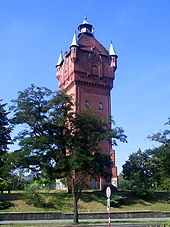Śrem
| Śrem | ||
|---|---|---|

|
|
|
| Basic data | ||
| State : | Poland | |
| Voivodeship : | Greater Poland | |
| Powiat : | Śrem | |
| Gmina : | Śrem | |
| Area : | 12.38 km² | |
| Geographic location : | 52 ° 5 ' N , 17 ° 1' E | |
| Residents : | 29,566 (June 30, 2019) | |
| Postal code : | 63-100 | |
| Telephone code : | (+48) 61 | |
| License plate : | PSE | |
| Economy and Transport | ||
| Street : | Leszno - Września | |
| Next international airport : | Poses | |
Śrem [ ˈɕrɛm ] ( German Schrimm ) is a city in Poland in the Greater Poland Voivodeship . It is the seat of the town-and-country municipality of the same name with 42,069 inhabitants (as of June 30, 2019) and the district town of the Powiat Śremski .
Geographical location
The city is located on the Warta , about 40 kilometers south of the city of Poznan .
history

At the end of the 10th or the beginning of the 11th century there was a fortification on the site of today's Śrem. From 1136, the first written reference dates of the place by Pope Innocent II. In 1253 was the place that was on the left bank of the Warta, by Duke Boleslaw the Pious , the city charter . In 1293 the right to the settlement on the right bank was transferred, as the place had previously been destroyed. In 1393 the town charter was confirmed. In 1424 Władysław II. Jagiełło allowed the construction of a bridge over the Warta. In 1635 the plague raged in the city. In 1736 the river overflowed and destroyed most of the city.
In 1793 during the Second Partition of Poland , the place became part of Prussia , but remained a district town. In 1818 Schrimm became a district town in the province of Posen. In 1884 the place was connected to the railway network .
After the First World War , the city was incorporated into the Second Polish Republic in 1919 . In 1932 a non-commissioned officer school opened in Śrem.
In September 1939, the site was occupied by the National Socialists and public executions took place .
Towards the end of World War II , the city was liberated by the Red Army in January 1945 and returned to Poland.
From 1946 to 1975 the “Jeziorany” block of flats is built. In 1968 a foundry is opened. In 1975 the town lost its seat as the Powiat capital , but regained it in 1999 after a further administrative reform.
- Population development
| year | Population community |
City population |
|---|---|---|
| 1910 | ? | 6,993 |
| 1977 | 30,064 | 21,197 |
| 1980 | 30,771 | 21,876 |
| 1984 | 32,928 | 24,223 |
| 1989 | 36,336 | 27,719 |
| 1993 | 37,963 | 29,180 |
| 1996 | 39,075 | 30,268 |
| 2000 | 39,589 | 31,724 |
| 2003 | 39,583 | ? |
local community
The town itself and 32 villages with school boards belong to the town-and-country municipality (gmina miejsko-wiejska) Śrem with an area of almost 206 km².
Partnerships
- Bergen , Germany
- Rožnov pod Radhoštěm , Czech Republic
Personalities
Seckel Bamberger worked as a rabbi and religion teacher in Schrimm from 1887 to 1902. The Polish politician Franciszek Trąbalski (PPS, PZPR) went to school in Śrem.
In Schrimm were born:
- Julius Schreiber (1848–1932), internist and university professor in Königsberg
- Karl Weidel (1875–1943) religious educator and provost
- Eugen Wednesday (1876–1942), Orthodox rabbi, founder of contemporary Islamic studies in Germany and an expert on Amharic / Ethiopian
- Heinrich Reisner (1881–1969), civil engineer and founder of the Haus der Technik in Essen
- Hermann Schreiber (1882–1954), rabbi and publicist
- Jacob Jacobson (1888–1968), historian and genealogist
- Günter Christmann (* 1942), free jazz musician.
literature
- Heinrich Wuttke : City book of the country Posen. Codex diplomaticus: General history of the cities in the region of Poznan. Historical news from 149 individual cities . Leipzig 1864, pp. 444-446.



